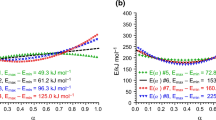Abstract
Using theoretically simulated kinetic datasets, the performance of various types of commonly accessible baselines was tested when the heat capacity of reactants and products is not the same. The quality of the approximation of the true thermokinetic background was compared to the (correct) tangential area-proportional interpolation. Undoubtedly, the most accurate results were provided by the Bezier interpolation, followed by the cubic spline function. In the case of the cubic spline, however, great care needs to be paid to its setting to perform acceptably. The worst results were provided by the simple linear interpolation. Regarding the accuracy of the consequent kinetic analysis, even in the case of large heat capacity changes underlying the kinetic peak, the evaluation of apparent activation energy and pre-exponential factor (model-free analysis) showed only negligible errors for all three tested types of baselines. However, larger heat capacity changes resulted in considerable errors (even ~30 %) in the integral area under the peak. Model-based kinetic analysis provided varied results for different methodologies; while the multivariate curve-fitting exhibited acceptable (small) deviations, the peak-shaped analysis provided considerably worse results, particularly the application of the simple linear interpolation led to large errors.








Similar content being viewed by others
References
Höhne G, Hemminger W, Flammersheim HJ. Differential scanning calorimetry. Berlin: Springer; 2003.
Schoenberg IJ. Contributions to the problem of approximation of equidistant data by analytic functions. Part A: on the problem of smoothing of graduation. A first class of analytic approximation formulae. Quart Appl Math. 1946;4:45–99.
Bartels RH, Beatty JC, Barsky BA, Bézier P, Forrest AR. An introduction to splines for use in computer graphics and geometric modelling. San Francisco: Morgan Kaufmann Publishers Inc.; 1998.
Johnson WA, Mehl KF. Reaction kinetics in processes of nucleation and growth. Trans Am Inst Min (Metall) Eng. 1939;135:416–42.
Avrami M. Kinetics of phase change I–general theory. J Chem Phys. 1939;7:1103–12.
Avrami M. Kinetics of phase change. II–transformation-time relations for random distribution of nuclei. J Chem Phys. 1940;7:212–24.
Avrami M. Granulation, phase change, and microstructure—kinetics of phase change III. J Chem Phys. 1941;7:177–84.
Ozawa T. Kinetic analysis of derivative curves in thermal analysis. J Therm Anal. 1970;2:301–24.
Kissinger HE. Reaction kinetics in differential thermal analysis. Anal Chem. 1957;29:1702–6.
Friedman HL. Kinetics of thermal degradation of char-forming plastics from thermogravimetry. Application to a phenolic plastic. New York: Wiley Subscription Services Inc, A Wiley Company; 1964.
Flynn JH, Wall LA. A quick, direct method for the determination of activation energy from thermogravimetric data. J Polym Sci B Polym Lett. 1966;4:323–8.
Opfermann J. Kinetic analysis using multivariate non-linear regression. I. Basic concepts. J Therm Anal Calorim. 2000;60:641–58.
Opfermann JR, Kaisersberger E, Flammersheim HJ. Model-free analysis of thermoanalytical data-advantages and limitations. Thermochim Acta. 2002;391:119–27.
Málek J. Kinetic analysis of crystallization processes in amorphous materials. Thermochim Acta. 2000;355:239–53.
Málek J. The kinetic analysis of non-isothermal data. Thermochim Acta. 1992;200:257–69.
Vyazovkin S, Burnham AK, Criado JM, Pérez-Maqueda LA, Popescu C, Sbirrazzuoli N. ICATC kinetics committee recommendations for performing kinetic computations on thermal analysis data. Thermochim Acta. 2011;520:1–19.
Svoboda R, Málek J. Interpretation of crystallization kinetics results provided by DSC. Thermochim Acta. 2011;526:237–51.
Svoboda R, Málek J. Extended study of crystallization kinetics for Se–Te glasses. J Therm Anal Calorim. 2013;111:161–71.
Svoboda R, Málek J. Particle size influence on crystallization behavior of Ge2Sb2Se5 glass. J Non-Cryst Sol. 2012;358:276–84.
Acknowledgements
This work has been supported by the Czech Science Foundation under project No. 16-10562S.
Author information
Authors and Affiliations
Corresponding author
Electronic supplementary material
Below is the link to the electronic supplementary material.
Rights and permissions
About this article
Cite this article
Svoboda, R., Málek, J. Importance of proper baseline identification for the subsequent kinetic analysis of derivative kinetic data. J Therm Anal Calorim 124, 1717–1725 (2016). https://doi.org/10.1007/s10973-016-5297-x
Received:
Accepted:
Published:
Issue Date:
DOI: https://doi.org/10.1007/s10973-016-5297-x




